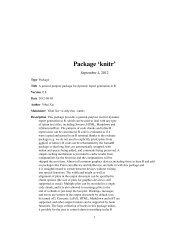Package 'openair'
Package 'openair'
Package 'openair'
Create successful ePaper yourself
Turn your PDF publications into a flip-book with our unique Google optimized e-Paper software.
timePlot 125Argumentsmydatapollutantgroupstacknormaliseavg.timedata.threshstatisticpercentiledate.padA data frame of time series. Must include a date field and at least one variableto plot.Name of variable to plot. Two or more pollutants can be plotted, in which casea form like pollutant = c("nox", "co") should be used.If more than one pollutant is chosen, should they all be plotted on the same graphtogether? The default is FALSE, which means they are plotted in separate panelswith their own scaled. If TRUE then they are plotted on the same plot with thesame scale.If TRUE the time series will be stacked by year. This option can be useful ifthere are several years worth of data making it difficult to see much detail whenplotted on a single plot.Should variables be normalised? The default is is not to normalise the data.normalise can take two values, either “mean” or a string representing a date inUK format e.g. "1/1/1998" (in the format dd/mm/YYYY). If normalise = "mean"then each time series is divided by its mean value. If a date is chosen, then valuesat that date are set to 100 and the rest of the data scaled accordingly. Choosing adate (say at the beginning of a time series) is very useful for showing how trendsdiverge over time. Setting group = TRUE is often useful too to show all timeseries together in one panel.This defines the time period to average to. Can be “sec”, “min”, “hour”, “day”,“DSTday”, “week”, “month”, “quarter” or “year”. For much increased flexibilitya number can precede these options followed by a space. For example,a timeAverage of 2 months would be period = "2 month". See functiontimeAverage for further details on this.The data capture threshold to use (%) when aggregating the data using avg.time.A value of zero means that all available data will be used in a particular periodregardless if of the number of values available. Conversely, a value of 100 willmean that all data will need to be present for the average to be calculated, else itis recorded as NA. Not used if avg.time = "default".The statistic to apply when aggregating the data; default is the mean. Can beone of “mean”, “max”, “min”, “median”, “frequency”, “sd”, “percentile”. Notethat “sd” is the standard deviation and “frequency” is the number (frequency)of valid records in the period. “percentile” is the percentile level (%) between0-100, which can be set using the “percentile” option - see below. Not used ifavg.time = "default".The percentile level in % used when statistic = "percentile" and whenaggregating the data with avg.time. More than one percentile level is allowedfor type = "default" e.g. percentile = c(50, 95). Not used if avg.time= "default".Should missing data be padded-out? This is useful where a data frame consistsof two or more "chunks" of data with time gaps between them. By settingdate.pad = TRUE the time gaps between the chunks are shown properly, ratherthan with a line connecting each chunk. For irregular data, set to FALSE. Note,this should not be set for type other than default.
















